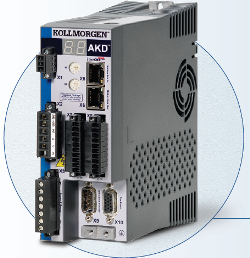Availability
 Unlike fieldbus communications only being supported by particular models of the AKD servo drive, Modbus TCP communication is supported by all of the AKD models (except the Profinet drive). Whether you have a simple "analog" drive, an indexing drive, or an AKD with BASIC programming, you have the capability of using Modbus communication. It is a simple, easy to use, standard communication protocol that can be used in a PC, PLC, or HMI to talk to any AKD drive.
Unlike fieldbus communications only being supported by particular models of the AKD servo drive, Modbus TCP communication is supported by all of the AKD models (except the Profinet drive). Whether you have a simple "analog" drive, an indexing drive, or an AKD with BASIC programming, you have the capability of using Modbus communication. It is a simple, easy to use, standard communication protocol that can be used in a PC, PLC, or HMI to talk to any AKD drive.
Necessity for Communication
Modbus TCP can be used by a master controller to set parameter values in the AKD. In many applications, the drive's digital and analog I/O are not enough for commanding the drive as desired. So a communication protocol is used to make configuration changes in the drive and send motion commands to the drive. There are many different communication protocols available, including EtherCAT, CANopen, Ethernet/IP, and Profinet, but Modbus TCP is by far the simplest without too much limitation of functionality.
Speed
Speed is usually a concern when using digital communication. Modbus TCP is not the fastest communication. It is limited to greater than about 20ms update rate, which, compared to most fieldbuses, is very slow. However, it is fast enough to read and write parameter values for the vast majority of servo applications. It is generally much easier to implement in a master device than Fieldbus protocols. In fact, Modbus in the AKD is about the same speed as Ethernet/IP and Profinet, and offers a lot more flexibility.
Usable Data
Modbus TCP does not provide a "real-time" data channel, as do fieldbuses, but it does allow access to almost all of the AKD drive's parameters. Fieldbuses, like CANopen, etc., have a "real-time" data channel that provides a Control Word and a Status Word and other data that is updated on a regular cycle time. Modbus does not support this type of communication. Modbus is simply a protocol that provides access to the drive's parameters. The protocol is fairly simple. The master device can read a parameter value from the AKD, and it can write a parameter value to the AKD. Each 32bit parameter consists of two registers, and each 64bit parameter consists of 4 registers. Each register has a number. In the master controller, you specify the register numbers to be read or written, and you specify whether it is reading those registers or writing values to them. It is very simple and straightforward.
Tell us about an application you tried utilizing Modbus TCP - what successes did you have? Where did you need to utilize one of the other fieldbus types and why?







